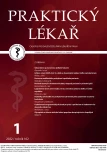Application of ergonomic principles when working on a computer for general medicine students
Authors:
J. Michalková; L. Dimunová; G. Štefková
Authors‘ workplace:
Ústav ošetrovateľstva
; Prednostka: prof. PhDr. Lucia Dimunová, PhD.
; Univerzita P. J. Šafárika v Košiciach, Lekárska fakulta
Published in:
Prakt. Lék. 2022; 102(1): 37-41
Category:
Of different specialties
Overview
Background: Our aim was to find out whether general medicine students have ergonomic principles knowledge when working on a computer. Subsequently, to identify whether gender differences and the number of hours of computer work relate to their overall level of ergonomic principles knowledge.
Methods: The sample consisted of 193 general medicine students. A non-standardized questionnaire was used for data collection, in which we focused on ergonomic principles related to the monitor, computer mouse, keyboard, chair and desk. The questionnaires were distributed in May 2019. The data were evaluated by the statistical program SPSS 20.0 and interpreted using the methods of descriptive and inductive statistics.
Results: Students have ergonomic principles knowledge when working on a computer in the range of correct answers from 41–82%. We did not record any significant differences according to the gender. The average time spent working on a computer was 3,40 hours per day and 22,50 hours per week. A statistically significant relationship was only confirmed for students who spent more than 40 hours a week working on a computer. It refers that this group had less ergonomic principles knowledge.
Conclusion: From comprehensive view students have ergonomic principles knowledge when working on a computer, but not in a sufficient extent. The survey results confirmed the need to support the topic of ergonomic in the educational process.
Keywords:
students – ergonomic principles – working on a computer
Sources
1. Azizi A, Alaei A, Walaee N, et al. Comparison of the effect of virtual teaching method (e) with lecture method on students’ learning in the course of oral and maxillofacial diseases and their satisfaction. JDS 2017; 14(1): 57–62.
2. Čelko J. Využitie krokomeru v prevencii a liečbe. Rehabilitácia 2014; 51(2): 67–78.
3. Dabaghi-Tabriz F, Bahramian A, Rahbar M, et al. Ergonomic evaluation of senior undergraduate students and effect of instruction regarding ergonomic principles on It. Maedica (Bucur) 2020; 15(1): 81–86.
4. Dabek J, Piotrkowicz J, Korzeń D, et al. Knowledge and use of ergonomic principles in physicians and nurses with low back pain. Health Prob Civil 2019; 13(3): 217–224.
5. Gabriška P. Pracovisko a počítač. Príloha č. 1 k smernici č. 7/2015 zásady a pravidlá bezpečného správania sa na pracovisku [online]. Dostupné z: https://www.stupava.sk/e_download.php?file=data/ uredni_deska/obsah1061_1.pdf&original=Smernica-72015-priloh- 1.pdf [cit. 2021-04-24].
6. Gúth A. Bolesť a škola chrbtice. 5. vydanie Bratislava: Liečreh 2017.
7. Hanani S, Ghasemi S, Safari Y, et al. Comparison the effect of educational enterventions based on brochure and virtual educationin compliance principles of ergonomic operating room technologist of Iran University of Medical Sciences. J Clin Res Paramed Sci 2019; 8(2): e88428.
8. Hitka M, Lorincová S. Ergonómia. Zvolen: TU 2018.
9. Horváthová B, Dulina L, Bigošová E, Gašo M. Ergonomické aspekty sedavého zamestnania. Fórum manažéra 2019; 15(1): 23–30.
10. Hussain HM, Khanzada SR, Khan K, et al. Awareness of good posture and computer ergonomics among medical students of Isra University. Int J Physiother 2015; 2(6): 987–991.
11. Kaščáková M, Obročníková A, Majerníková Ľ. Fenomén zrakovej záťaže pri práci na počítači. Molisa 10 Medicínsko – ošetrovateľské listy Šariša. Prešov: PU 2013; 69–76.
12. Katrova LG. Teaching dental ergonomics to undergraduate dental students. Why and how? The experience of the Faculty of Dental Medicine of Sofia, Bulgaria. Stomatological Dis Sci 2017; 1: 69–75.
13. Kotradyová V. 11 vlastností podporného prostredia pre človeka /inter- a multidisciplinárny výskum v BCDLab. In: Ergonómia 2017 – Berieme ergonómiu vážne. [online]. Žilina: Slovenská ergonomická spoločnosť 2017; 101–117. Dostupné z: http:// ergonomicka.sk/SES/?page_id=1502 [cit. 2021-04-24].
14. Ladányi D. Ergonómia na pracovisku [online]. Dostupné z: https:// worklife.sk/praca-a-zivot/ergonomia-na-pracovisku/ [cit. 2021-04-24].
15. Logaraj M, Madhu Priya V, Seetharaman N, et al. Practice of ergonomic principles and computer vision syndrome (cvs) among undergraduates students in Chennai. Natl J Med Res 2013; 3(2): 111–116.
16. Malý S, a kol. Ergonomické stresory pod kontrolou aneb Ergonomie – jak na to. 2. vydání. Praha: Výzkumný ústav bezpečnosti práce 2019.
17. Nariadenie vlády SR č. 276/2006 Z.z. o minimálnych bezpečnostných a zdravotných požiadavkách pri práci so zobrazovacími jednotkami.
18. Sirajudeen MS, Muthusamy H, Alqahtani M, et al. Computerrelated health problems among university students in Majmaah region, Saudi Arabia. Biomedical Research 2018; 29(11): 2405– 2415.
19. Szilágyiová K. Zraková záťaž v pracovnom prostredí [online]. Dostupné z: https://zdravievpraci.sk/zrakova-zataz-v-pracovnom- prostredi/ [cit. 2021-04-24].
20. Tilhon J. Participativní ergonomie - nutný krok k rozpoznání ergonomických aspektů pracovníky [online]. Dostupné z: http:// ergonomicka.sk/SES/?pageid=1502 [cit. 2021-04-24].
21. Vavrek M. Ergonómia [online]. Dostupné z: http://edu.fmph. uniba.sk/~winczer/SocialneAspekty/VavrekErgonomia.html [cit. 2021-04-24].
Labels
General practitioner for children and adolescents General practitioner for adultsArticle was published in
General Practitioner

2022 Issue 1
Most read in this issue
- Legislative framework of brain death versus irreversible circulatory arrest in the Czech Republic
- Prevention of medication mistake from a patient’s perspective
- Overview of instruments assessing the patient safety culture in primary care
- Secondary mushroom poisoning
